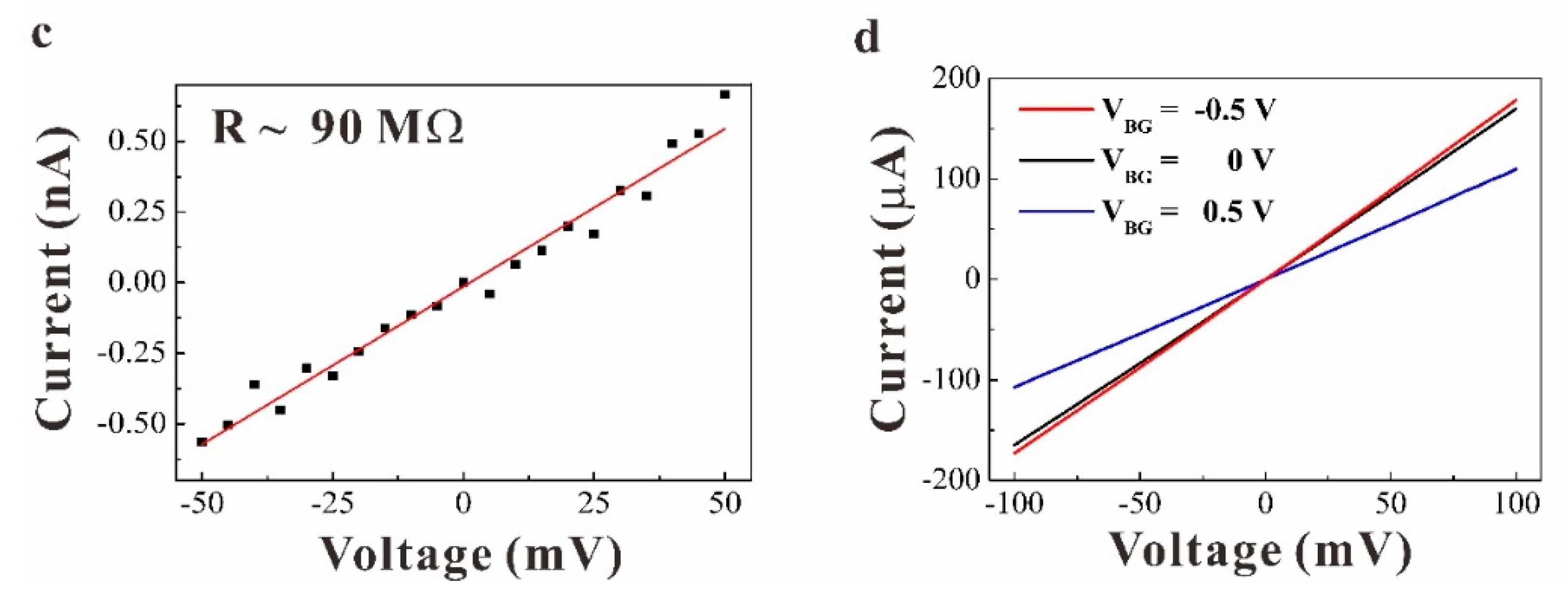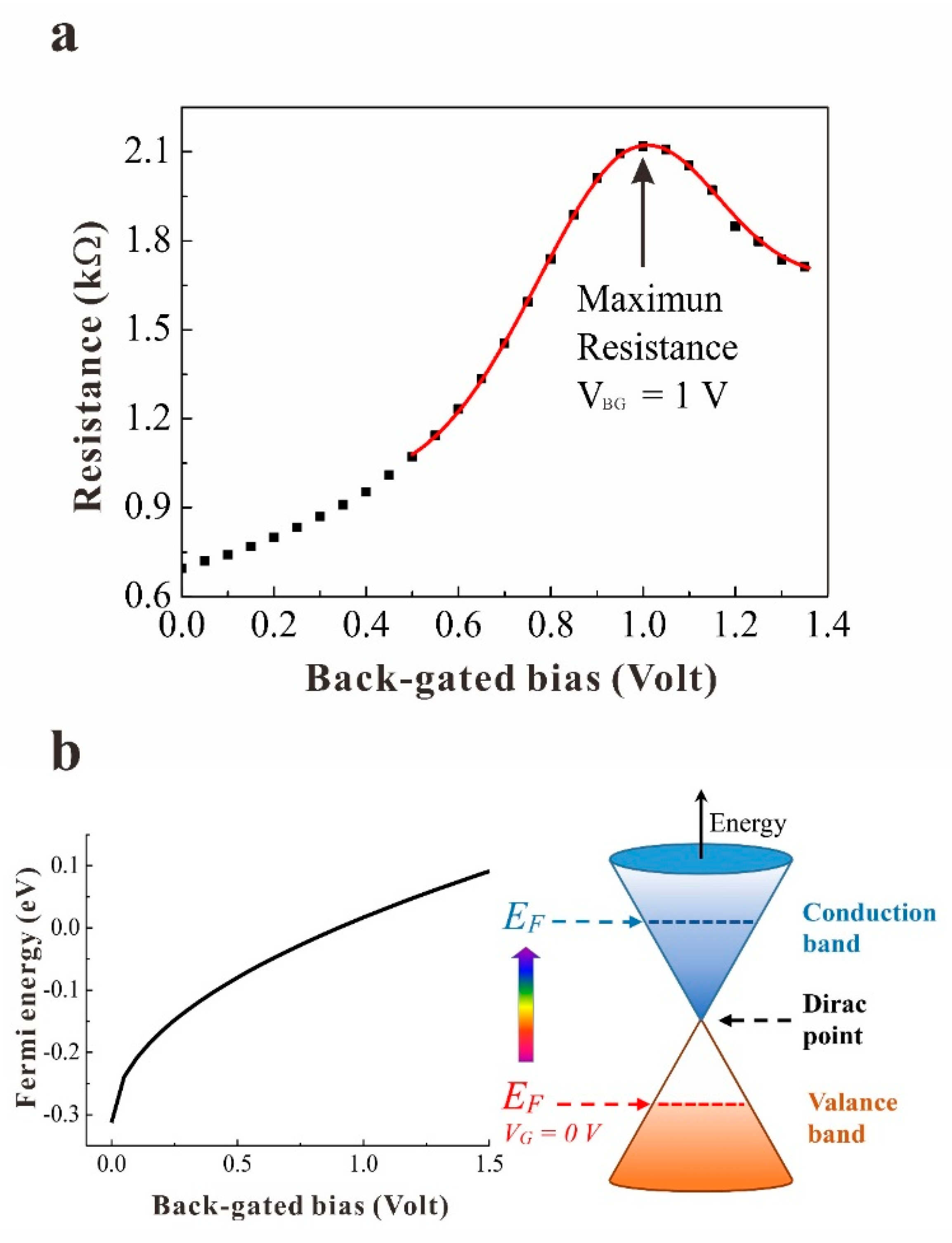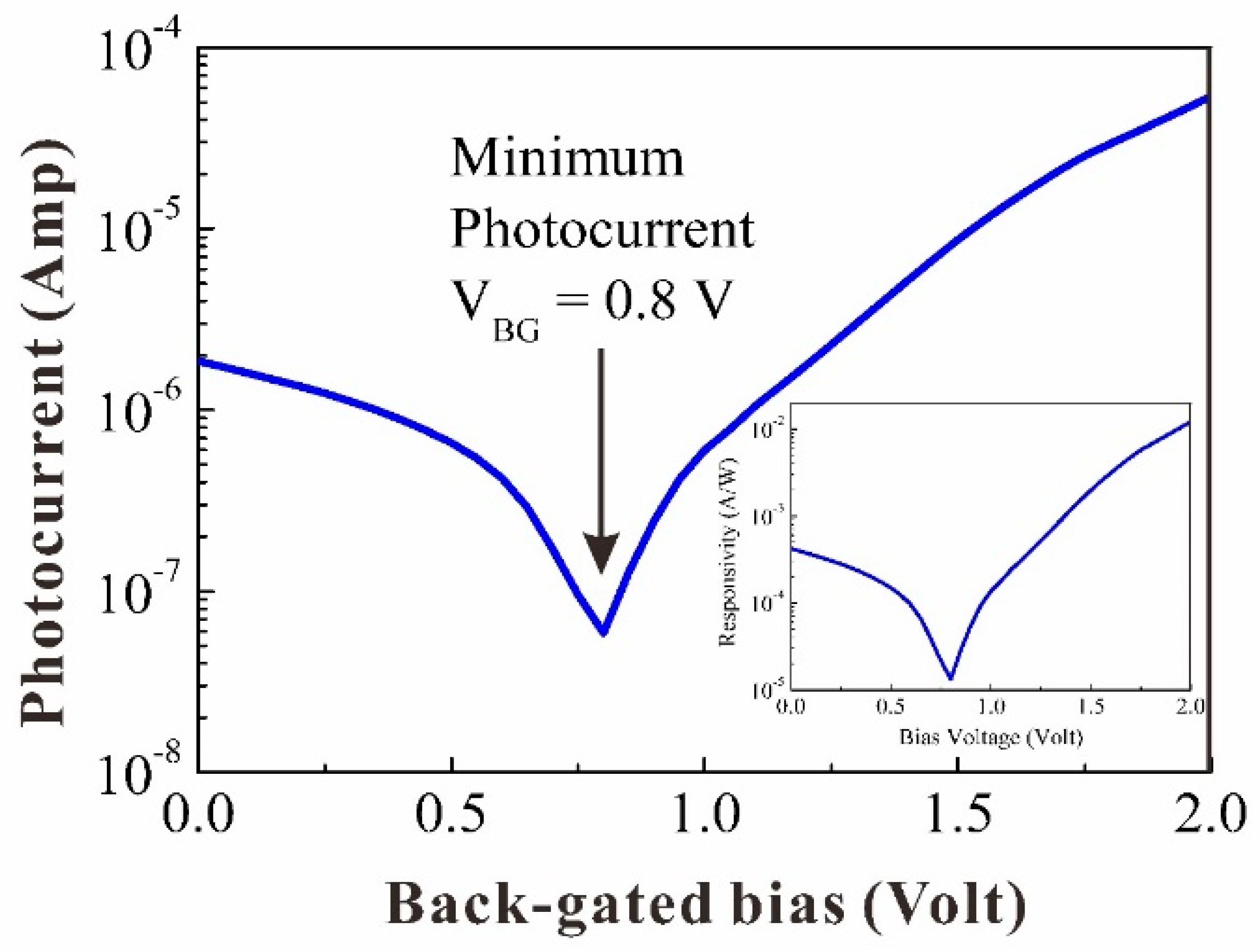Photoresponse of Graphene Channel in Graphene-Oxide–Silicon Photodetectors
Abstract
1. Introduction
2. Methodology
3. Results and Discussions
4. Conclusions
Supplementary Materials
Author Contributions
Funding
Institutional Review Board Statement
Informed Consent Statement
Data Availability Statement
Acknowledgments
Conflicts of Interest
References
- Koppens, F.H.L.; Mueller, T.; Avouris, P.; Ferrari, A.C.; Vitiello, M.S.; Polini, M. Photodetectors based on graphene, other two-dimensional materials and hybrid systems. Nat. Nanotechnol. 2014, 9, 780–793. [Google Scholar] [CrossRef] [PubMed]
- Rogalski, A.; Kopytko, M.; Martyniuk, P. Two-dimensional infrared and terahertz detectors: Outlook and status. Appl. Phys. Rev. 2019, 6, 021316. [Google Scholar] [CrossRef]
- Capista, D.; Lozzi, L.; Pelella, A.; Di Bartolomeo, A.; Giubileo, F.; Passacantando, M. Spatially Resolved Photo-Response of a Carbon Nanotube/Si Photodetector. Nanomaterials 2023, 13, 650. [Google Scholar] [CrossRef] [PubMed]
- Rehman, M.A.; Park, S.; Khan, M.F.; Bhopal, M.F.; Nazir, G.; Kim, M.; Farooq, A.; Ha, J.; Rehman, S.; Jun, S.C.; et al. Development of directly grown-graphene–silicon Schottky barrier solar cell using co-doping technique. Int. J. Energy Res. 2022, 46, 11510–11522. [Google Scholar] [CrossRef]
- Pelella, A.; Grillo, A.; Faella, E.; Luongo, G.; Askari, M.B.; Di Bartolomeo, A. Graphene−Silicon Device for Visible and Infrared Photodetection. ACS Appl. Mater. Interfaces 2021, 13, 47895–47903. [Google Scholar] [CrossRef]
- Jiang, J.; Wen, Y.; Wang, H.; Yin, L.; Cheng, R.; Liu, C.; Feng, L.; He, J. Recent Advances in 2D Materials for Photodetectors. Adv. Electron. Mater. 2021, 7, 2001125. [Google Scholar] [CrossRef]
- Wang, Y.; Ho, V.X.; Pradhan, P.; Cooney, M.P.; Vinh, N.Q. Effect of High-κ Dielectric Layer on 1/f Noise Behavior in Graphene Field-Effect Transistors. ACS Appl. Nano Mater. 2021, 4, 8539–8545. [Google Scholar] [CrossRef]
- Zhang, Y.; Liu, T.; Meng, B.; Li, X.; Liang, G.; Hu, X.; Wang, Q.J. Broadband high photoresponse from pure monolayer graphene photodetector. Nat. Commun. 2013, 4, 1811. [Google Scholar] [CrossRef]
- Scagliotti, M.; Salvato, M.; Crescenzi, M.D.; Mishra, N.; Fabbri, F.; Miseikis, V.; Coletti, C.; Catone, D.; Mario, L.D.; Boscardin, M.; et al. Large-area, high-responsivity, fast and broadband graphene/n-Si photodetector. Nat. Nanotechnol. 2021, 32, 155504. [Google Scholar] [CrossRef]
- Fukushima, S.; Shimatani, M.; Okuda, S.; Ogawa, S.; Kanai, Y.; Ono, T.; Inoue, K.; Matsumoto, K. Photogating for small high-responsivity graphene middle-wavelength infrared photodetectors. Opt. Eng. 2020, 59, 037101. [Google Scholar] [CrossRef]
- Elahi, E.; Khan, M.F.; Rehman, S.; Khalil, H.M.W.; Rehman, M.A.; Kim, D.; Kim, H.; Khan, K.; Shahzad, M.; Iqbal, M.W.; et al. Enhanced electrical and broad spectral (UV-Vis-NIR) photodetection in a Gr/ReSe2/Gr heterojunction. Dalton Trans. 2020, 49, 10017–10027. [Google Scholar] [CrossRef] [PubMed]
- Zeng, L.H.; Wang, M.Z.; Hu, H.; Nie, B.; Yu, Y.Q.; Lu, C.Y.; Wang, L.; Hu, J.G.; Xie, C.; Liang, F.X.; et al. Monolayer Graphene/Germanium Schottky Junction As High-Performance Self-Driven Infrared Light Photodetector. ACS Appl. Mater. Interfaces 2013, 5, 9362–9366. [Google Scholar] [CrossRef] [PubMed]
- Lv, Y.; Li, H.; Lee, K.C.; Chang, G.E.; Shieh, T.H.; Wu, X.S.; Chang, C.R.; Wu, H.C.; Hung, K.M.; Cheng, H.H. Amplifying photocurrent of graphene on GeSn film by sandwiching a thin oxide between them. Appl. Phys. Lett. 2020, 117, 152106. [Google Scholar] [CrossRef]
- Yang, F.; Yu, K.; Cong, H.; Xue, C.; Cheng, B.; Wang, N.; Zhou, L.; Liu, Z.; Wang, Q. Highly Enhanced SWIR Image Sensors Based on Ge1–xSnx–Graphene Heterostructure Photodetector. ACS Photonics 2019, 6, 1199–1206. [Google Scholar] [CrossRef]
- Riazimehr, S.; Kataria, S.; Bornemann, R.; Bolivar, P.H.; Ruiz, F.J.G.; Engstrom, O.; Godoy, A.; Lemme, M.C. High Photocurrent in Gated Graphene–Silicon Hybrid Photodiodes. ACS Photonics 2017, 4, 1506–1514. [Google Scholar] [CrossRef]
- Fukushima, S.; Shimatani, M.; Okuda, S.; Ogawa, S.; Kanai, Y.; Ono, T.; Inoue, K.; Matsumoto, K. Low dark current and high-responsivity graphene mid-infrared photodetectors using amplification of injected photo-carriers by photo-gating. Opt. Lett. 2019, 44, 2598–2601. [Google Scholar] [CrossRef]
- Kobayashi, S.; Anno, Y.; Takei, K.; Arie, T.; Akita, S. Photoresponse of graphene field-effect-transistor with n-type Si depletion layer gate. Sci. Rep. 2018, 8, 4811. [Google Scholar] [CrossRef]
- Park, H.K.; Choi, J. High Responsivity and Detectivity Graphene-Silicon Majority Carrier Tunneling Photodiodes with a Thin Native Oxide Layer. ACS Photonics 2018, 5, 2895–2903. [Google Scholar] [CrossRef]
- Leenaerts, O.; Partoens, B.; Peeters, F.M. Adsorption of H2O, NH3, CO, NO2, and NO on graphene: A first-principles study. Phys. Rev. B 2008, 77, 125416. [Google Scholar] [CrossRef]
- Hernandez, M.; Oca, A.C.M.D.; Leyva, M.O.; Naumis, G.G. How water makes graphene metallic. Phys. Lett. A 2019, 383, 125904. [Google Scholar] [CrossRef]
- Rana, F. Electron-hole generation and recombination rates for Coulomb scattering in graphene. Phys. Rev. B 2007, 76, 155431. [Google Scholar] [CrossRef]
- Yan, R.; Zhang, Q.; Li, W.; Calizo, I.; Shen, T.; Richter, C.A.; Walker, A.R.H.; Liang, X.; Seabaugh, A.; Jena, D.; et al. Determination of graphene work function and graphene-insulator-semiconductor band alignment by internal photoemission spectroscopy. Appl. Phys. Lett. 2012, 101, 022105. [Google Scholar] [CrossRef]
- Bartolomeo, A.D. Graphene Schottky diodes: An experimental review of the rectifying graphene/semiconductor heterojunction. Phys. Rep. 2016, 606, 1–58. [Google Scholar] [CrossRef]
- Xu, K.; Zeng, C.; Yan, R.; Ye, P.; Wang, K.; Seabaugh, A.C.; Xing, H.G.; Suehle, J.S.; Richter, C.A.; Gundlach, D.J.; et al. Direct Measurement of Dirac Point Energy at the Graphene/Oxide Interface. Nano Lett. 2013, 13, 131–136. [Google Scholar] [CrossRef] [PubMed]
- Rehman, M.A.; Akhtar, I.; Choi, W.; Akbar, K.; Farooq, A.; Hussain, S.; Shehzad, M.A.; Chun, S.H.; Jung, J.; Seo, Y. Influence of an Al2O3 interlayer in a directly grown graphene-silicon Schottky junction solar cell. Carbon 2018, 132, 157–164. [Google Scholar] [CrossRef]
- Peng, S.A.; Jin, Z.; Ma, P.; Zhang, D.Y.; Shi, J.Y.; Niu, J.B.; Wang, X.Y.; Wang, S.Q.; Li, M.; Liu, X.Y.; et al. The sheet resistance of graphene under contact and its effect on the derived specific contact resistivity. Carbon 2015, 82, 500–505. [Google Scholar] [CrossRef]
- Wang, Q.; Kitaura, R.; Suzuki, S.; Miyauchi, Y.; Yamamoto, K.M.Y.; Arai, S.; Shinohara, H. Fabrication and In Situ Transmission Electron Microscope Characterization of Free-Standing Graphene Nanoribbon Devices. ACS Nano 2016, 10, 1475–1480. [Google Scholar] [CrossRef]
- Craciun, M.F.; Russo, S.; Yamamoto, M.; Tarucha, S. Tuneable electronic properties in graphene. Nano Today 2011, 6, 42–60. [Google Scholar] [CrossRef]
- Luo, F.; Zhu, M.; Tan, Y.; Sun, H.; Luo, W.; Peng, G.; Zhu, Z.; Zhang, X.A.; Qin, S. High responsivity graphene photodetectors from visible to near-infrared by photogating effect. AIP Adv. 2018, 8, 115106. [Google Scholar] [CrossRef]
- Liu, F.; Kar, S. Quantum Carrier Reinvestment-Induced Ultrahigh and Broadband Photocurrent Responses in Graphene–Silicon Junctions. ACS Nano 2014, 8, 10270–10279. [Google Scholar] [CrossRef]
- Guo, X.; Wang, W.; Nan, H.; Yu, Y.; Jiang, J.; Zhao, W.; Li, J.; Zafar, Z.; Xiang, N.; Ni, Z.; et al. High-performance graphene photodetector using interfacial gating. Optical 2016, 3, 1066–1070. [Google Scholar] [CrossRef]
- ACS Material. Available online: https://www.acsmaterial.com/ (accessed on 1 May 2023).
- Stubrov, Y.; Nikolenko, A.; Gubanov, V.; Strelchuk, V. Manifestation of Structure of Electron Bands in Double-Resonant Raman Spectra of Single-Walled Carbon Nanotubes. Nanoscale Res. Lett. 2016, 11, 2. [Google Scholar] [CrossRef] [PubMed]
- Heo, G.; Kim, Y.S.; Chun, S.H.; Seong, M.J. Polarized Raman spectroscopy with differing angles of laser incidence on single-layer graphene. Nanoscale Res. Lett. 2016, 10, 45. [Google Scholar] [CrossRef]
- Han, M.Y.; Özyilmaz, B.; Zhang, Y.; Kim, P. Energy Band-Gap Engineering of Graphene Nanoribbons. Phys. Rev. Lett. 2007, 98, 206805. [Google Scholar] [CrossRef] [PubMed]
- Chen, Z.; Appenzeller, J. Mobility Extraction and Quantum Capacitance Impact in High Performance Graphene Field-effect Transistor Devices. IEEE Int. Electron Dev. Meet. 2008, 21, 509. [Google Scholar]
- Guo, X.; Wang, W.; Nan, H.; Yu, Y.; Jiang, J.; Zhao, W.; Li, J.; Zafar, Z.; Xiang, N.; Ni, Z.; et al. High-performance graphene photodetector using interfacial gating. Optical 2016, 3, 1066. [Google Scholar] [CrossRef]




Disclaimer/Publisher’s Note: The statements, opinions and data contained in all publications are solely those of the individual author(s) and contributor(s) and not of MDPI and/or the editor(s). MDPI and/or the editor(s) disclaim responsibility for any injury to people or property resulting from any ideas, methods, instructions or products referred to in the content. |
© 2023 by the authors. Licensee MDPI, Basel, Switzerland. This article is an open access article distributed under the terms and conditions of the Creative Commons Attribution (CC BY) license (https://creativecommons.org/licenses/by/4.0/).
Share and Cite
Lee, K.-C.; Chuang, Y.-H.; Huang, C.-K.; Li, H.; Chang, G.-E.; Hung, K.-M.; Cheng, H.H. Photoresponse of Graphene Channel in Graphene-Oxide–Silicon Photodetectors. Photonics 2023, 10, 568. https://doi.org/10.3390/photonics10050568
Lee K-C, Chuang Y-H, Huang C-K, Li H, Chang G-E, Hung K-M, Cheng HH. Photoresponse of Graphene Channel in Graphene-Oxide–Silicon Photodetectors. Photonics. 2023; 10(5):568. https://doi.org/10.3390/photonics10050568
Chicago/Turabian StyleLee, Kuo-Chih, Yu-Hsien Chuang, Chen-Kai Huang, Hui Li, Guo-En Chang, Kuan-Ming Hung, and Hung Hsiang Cheng. 2023. "Photoresponse of Graphene Channel in Graphene-Oxide–Silicon Photodetectors" Photonics 10, no. 5: 568. https://doi.org/10.3390/photonics10050568
APA StyleLee, K.-C., Chuang, Y.-H., Huang, C.-K., Li, H., Chang, G.-E., Hung, K.-M., & Cheng, H. H. (2023). Photoresponse of Graphene Channel in Graphene-Oxide–Silicon Photodetectors. Photonics, 10(5), 568. https://doi.org/10.3390/photonics10050568





